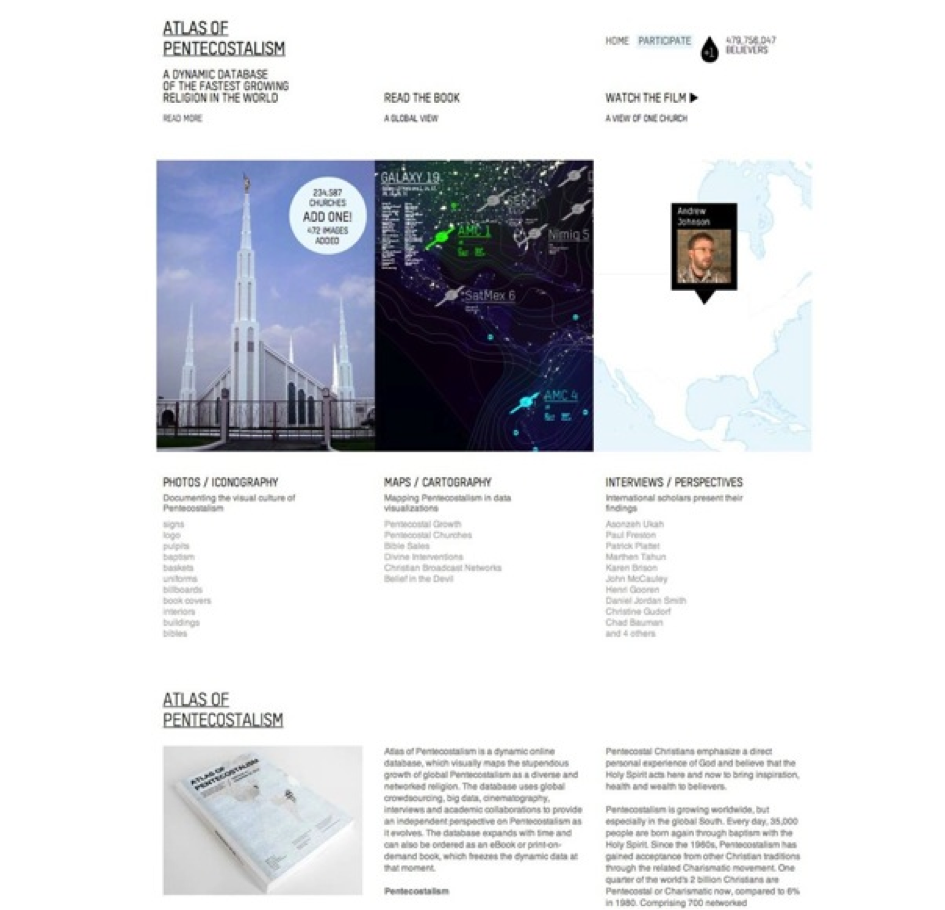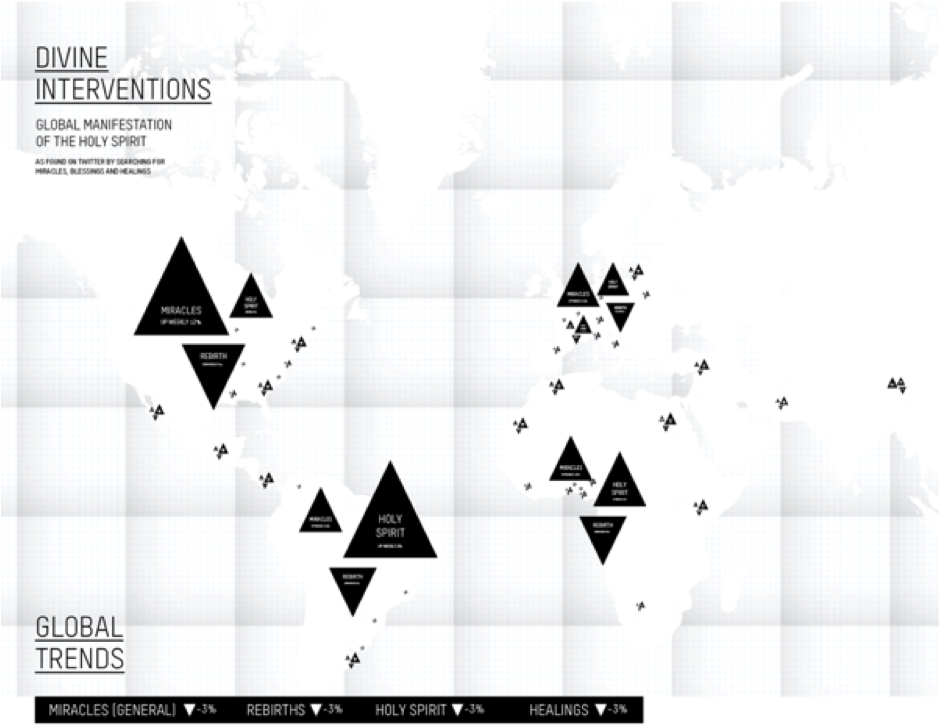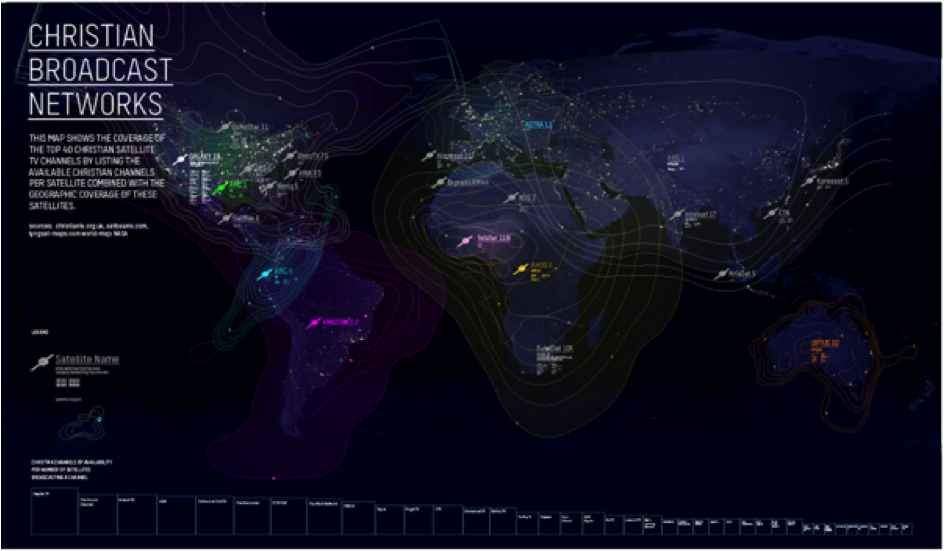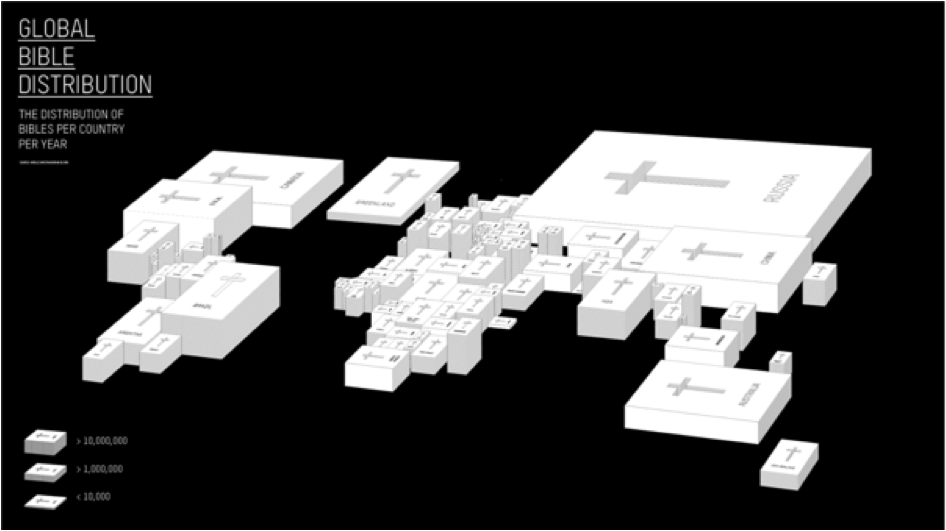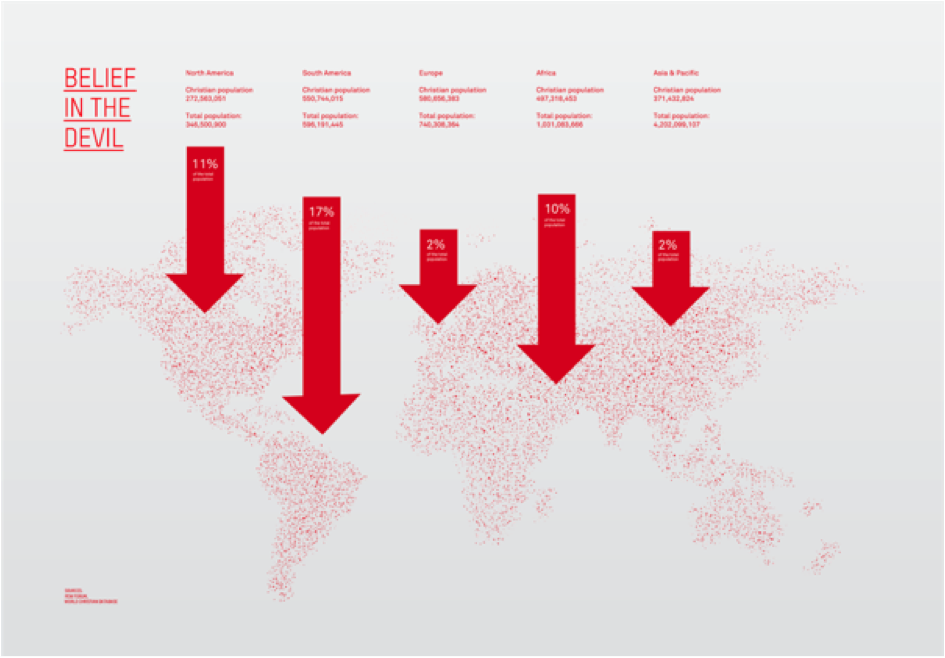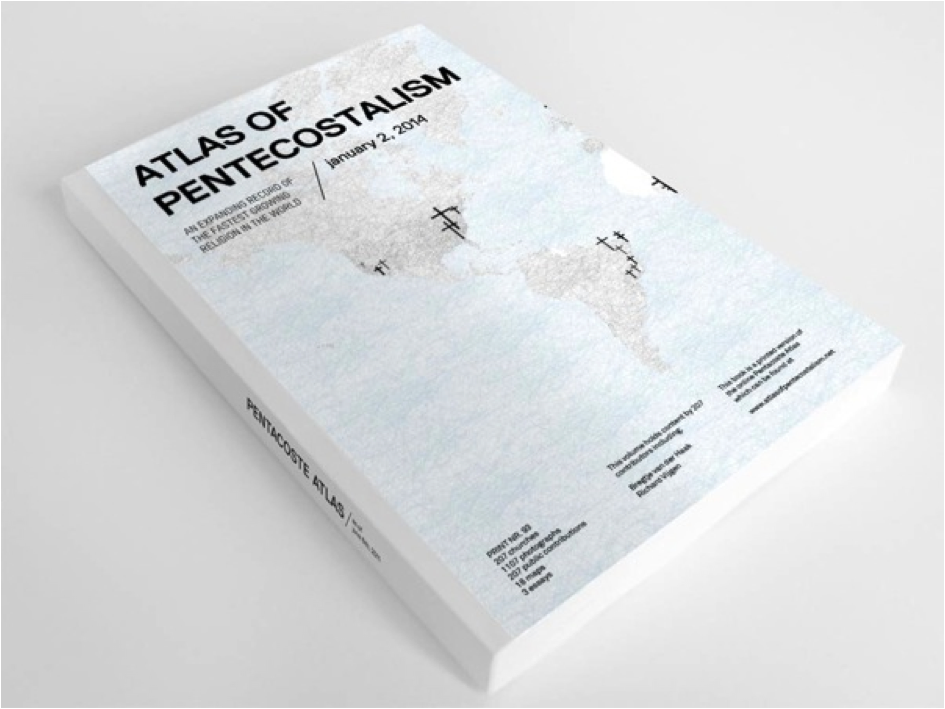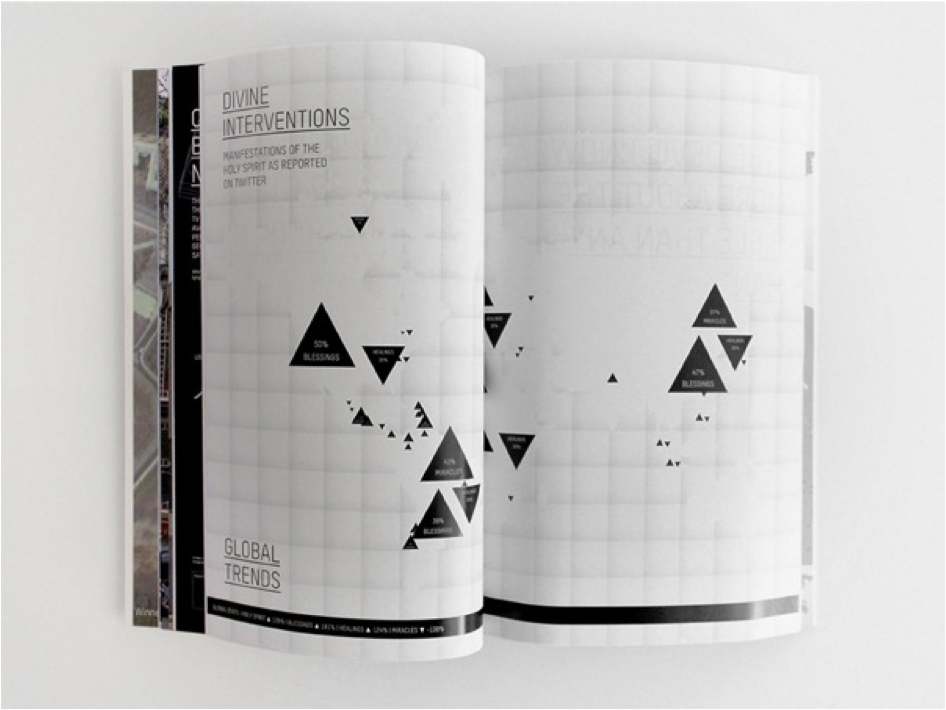(In November 2014, The Atlas of Pentecostalism project was exhibited at the International Documentary Festival Amsterdam’s DocLab show, an exhibition focused on trans-media storytelling. During this exhibition the online platform was displayed on a computer alongside a double-wide screen projection of the film Great Expectations.
Several versions of the print-on-demand book were available to read in the exhibition space and were also for sale at a neighboring bookstore, where new copies of the book were printed daily using an Expresso Bookmachine.
Bregtje van der Haak discusses the project in Dutch in a television interview for the Dutch documentary channel NPODoc.)
Massive Growth Under the Radar
Each day, 35,000 people are born again though baptism with the Holy Spirit. Since its beginning in Los Angeles in 1900, Pentecostalism, a branch of evangelical Protestantism, has spread over the world. The acceptance of Pentecostalism from other Christian traditions through the related Charismatic movement in the 1960s marked the beginning of a true global sprawl. Pentecostal Christians emphasize a direct personal experience of God and believe that the Holy Spirit acts here and now to bring inspiration, health and wealth to believers. Today, one quarter of the two billion Christians in the world are Pentecostal or Charismatic. Pentecostalism is the fastest growing religion in the world.
While the Pentecostal movement’s growth has been enormous, it has been taking place over several decades and in relative silence. With new members being baptized every three seconds its steady expansion has become normality, taking place in the background unnoticed by the daily news cycle.
Even though Pentecostalism is a global phenomenon, it has no central authority and presents itself in a wide variety—from the mega-churches that seat 100,000 people in Lagos, Nigeria to the informal office suites in European cities and the baroque cathedrals of the Philippines. However, in all these different environments Pentecostalism borrows methods from the corporate world, such as the use of the latest in communication technologies, massive video walls, satellite and internet broadcasting, and the promise of self fulfillment though advertising and self-help books. Local churches often compete with one another and set themselves apart through their corporate identities, logos and uniforms.
The Atlas of Pentecostalism aims to map this contemporary global phenomenon and its growth. It tries to identify and inventory Pentecostalism as a global, decentralized religion that uses modern methods to spread its message and expand its reach. Mapping a subject as diverse and intangible as Pentecostalism requires dealing with incompleteness, uncertainty, and different perspectives. The fact that Pentecostalism is growing means that any record of it is by definition out of date the moment that it’s published. So instead of trying to compile a definitive, scientific and complete description, we decided to embrace these uncertainties and tell the story of Pentecostalism in a way that is dynamic and layered—like the religion itself.
An expanding record
Unlike a traditional paper atlas, printed and bound, the Atlas of Pentecostalism is in essence a dynamic online database [image 2] which visually maps the growth of global Pentecostalism as a diverse and networked religion. The database uses global crowd-sourcing, big data, cinematography, interviews and academic collaborations to provide an independent perspective on Pentecostalism as it evolves. The database expands with time and can also be ordered as an e-book or print-on-demand book, which freezes the dynamic data at that moment.
The database consists of three main categories: iconography, a photo database documenting the visual culture of Pentecostalism, cartography, a set of interactive maps and data visualizations that aim to map Pentecostalism as it grows and interviews, a growing set of interviews with International scholars about their research.
The iconography chapter is divided into sub-chapters, each focusing on a specific visual aspect of Pentecostalism such as church buildings, bibles, interiors and logos.
This growing visual database consists of contributions from journalists, students and visitors of the website. Visitors can contribute to it by adding a church and uploading and tagging photos.
The cartography chapter contains a set of maps and data visualizations that each visualize a certain aspect of Pentecostalism. The map "Pentecostal Churches," for example, visualizes a data-set containing over 200,000 Pentecostal churches found on Google and keeps growing with each contribution to this website. Another map visualizes “Divine Interventions” in real-time. It shows the global manifestation of the Holy Spirit as reported on Twitter by searching for tweets about "Miracles," "Blessings" and "Healings" in real time. Other maps visualize subjects like “Christian Broadcast Networks,” “Global Bible Sales,” “Belief in the Devil,” and “Historical Pentecostal Growth.”
Lastly, the "Perspectives" chapters contain a growing set of interviews with international scholars and experts on Pentecostalism.
A growing book
Not only is the Atlas of Pentecostalism a growing database, it is also a growing book. Each day, a new version of the atlas is generated by a computer program and uploaded to the website. The book contains a frozen version of the database and is a static representation of all the maps, transcripts of the interviews and the entire iconographic database. The book can be downloaded from the website as an e-book or ordered as a full color print-on-demand book. Because the book is updated daily, each physical copy of the book is a unique snapshot that describes Pentecostalism at a specific point in time.
The book is designed programmatically; the lay-out and structure of the book are determined by changes in the database and the passing of time. The number of pages grows over time and a “live” chapter shows different fragments of news reports about Pentecostalism from around the world each day. Every book printed or downloaded from the website paints a slightly different picture of Pentecostalism while the big changes only become apparent after a longer period of time. Today the book has about 200 pages—one day it might be too big to print.
While the book provides a global view of Pentecostalism, the film Great Expectations, which is part of the website, zooms in on one church in Lagos, Nigeria. Rather then telling a story, the split screen documentary allows you to experience the emotional appeal and exuberant nature of Pentecostal worship. The film, which has no beginning and no end loops continuously and takes you to a new place every time you load the page. Each scene in the film has been tagged with keywords. These keywords allow for matches between a scene and specific items in the database: images, maps or parts of an interview that relate to that scene. These links allow you to explore the database and move back and forth between the film and other parts of the website. As the database continues to grow the relations between the film,and the database will change from day to day. The same principle is applied to the interviews, allowing for links between the interviews and other items in the database and between the interviews themselves.
While the database grows, relations between the various items in the database will continue to change, the book will grow, and this website will give new perspectives on the fastest growing religion in world.

